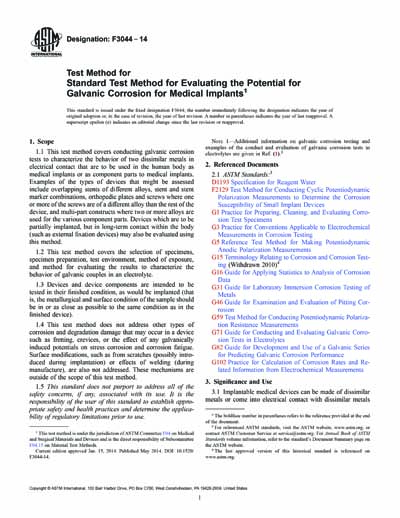Historical
ASTM F3044-14
Test Method for Standard Test Method for Evaluating the Potential for Galvanic Corrosion for Medical Implants
1.1 This test method covers conducting galvanic corrosion tests to characterize the behavior of two dissimilar metals in electrical contact that are to be used in the human body as medical implants or as component parts to medical implants. Examples of the types of devices that might be assessed include overlapping stents of different alloys, stent and stent marker combinations, orthopedic plates and screws where one or more of the screws are of a different alloy than the rest of the device, and multi-part constructs where two or more alloys are used for the various component parts. Devices which are to be partially implanted, but in long-term contact within the body (such as external fixation devices) may also be evaluated using this method.
1.2 This test method covers the selection of specimens, specimen preparation, test environment, method of exposure, and method for evaluating the results to characterize the behavior of galvanic couples in an electrolyte.
1.3 Devices and device components are intended to be tested in their finished condition, as would be implanted (that is, the metallurgical and surface condition of the sample should be in or as close as possible to the same condition as in the finished device).
1.4 This test method does not address other types of corrosion and degradation damage that may occur in a device such as fretting, crevices, or the effect of any galvanically induced potentials on stress corrosion and corrosion fatigue. Surface modifications, such as from scratches (possibly introduced during implantation) or effects of welding (during manufacture), are also not addressed. These mechanisms are outside of the scope of this test method.
1.5 This standard does not purport to address all of the safety concerns, if any, associated with its use. It is the responsibility of the user of this standard to establish appropriate safety and health practices and determine the applicability of regulatory limitations prior to use.
Content Provider
ASTM International [astm]






